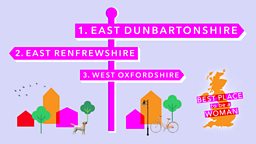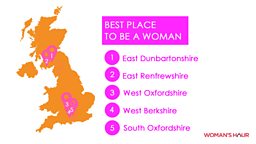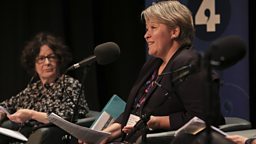How did we decide East Dunbartonshire is the 'best place to be a woman'?
Woman's Hour has named East Dunbartonshire in Scotland the ‘Best Place to be a Woman’ - but why? And why did Islington in North London come bottom of the list, when many women love living there? Nancy Kelly is director of Policy Research at NatCen, who crunched the numbers for us, and she explains how they carried out the study…

How is the list calculated?
We identified a range of indicators that we know have an impact on women’s quality of life. Some of them are very practical like average income or housing affordability, others are broader, like air quality and access to green spaces. Importantly, the index includes how women feel, using Office for National Statistics wellbeing indicators. We’ve also included indicators that are important to women at different times of their life to give us a sense of whether the best place for women to live changes as we age.
The aim was to create an index that helped us understand the best local areas for women to live in, and this meant we could only include indicators where the data was available at Local Authority level. This leaves some important gaps: for instance in health we measure wellbeing, life expectancy and healthy life expectancy after the age of 65, but we don’t have data on common health conditions, or diet.
The index allows us to rank all 380 Local Authorities in Great Britain from ‘best’ to ‘worst’ based on the available data.

What are the areas looked at and why?
The index covers a range of areas including work and income, housing affordability, wellbeing, life expectancy, education, safety, environment and culture.
This helps us understand the opportunities available to women where they live, the challenges they have to manage and how they feel on a day to day basis.
Of course, it doesn’t tell us where women should live – there are great things (as well as hard things) about living in every local authority in Britain, and what makes a place great for an individual woman is specific to her life and priorities.
What do the results show?
The top 5 local authorities are all relatively affluent areas that are either suburbs of cities, or part of the commuter belt for cities. Women living in these areas are near enough to cities to have access to good quality jobs as well great educational and cultural opportunities, and far enough away to avoid the downsides: cities are less safe, less affordable and have poorer quality environments.
The bottom 5 local authorities fall into two distinct groups. Some London boroughs do poorly because of a combination of very poor housing affordability and low levels of wellbeing, as well as issues with community safety and the quality of the environment.
The other local authorities at the bottom of the index share the same safety and environmental challenges as the London boroughs, but have weaker labour markets with lower pay and lower life expectancy.
The best and worst places to be a woman are similar across the life course – local authorities change their ranking on the index, but there are few radical moves. For younger women, shifts are largely driven by employment opportunities, for women aged 30-65 by school quality and employment opportunities; and for women over 65 by social isolation and local demographics.

What does this tell us?
At a simplistic level, it tells us that being near but not in major cities gives women access to both good resources and a good quality of life. However, choosing to live in these affluent commuter areas simply isn’t open to most women. In East Dunbartonshire, ranked number 1 in the index, the average house price is 7.5 times the average income, and this pattern is reflected across many of the higher scoring local authorities. If you don’t already live in one of these areas, buying your way into them is going to be challenging.
It also tells us that London, despite its amazing resources, great jobs and great schools, can be a very hard place to live. This is not just about house prices: Islington, which came last in the index scores 379th out of 380 on wellbeing, with very low levels of life satisfaction and one of the highest levels of anxiety.
And it tells us that a lot of women are still living in places where earning a decent living and staying healthy is far, far harder than it should be.

What were the challenges faced?
The main challenge was to find the quality data covering all of Great Britain and available at local authority level. There are indicators we’d like to have included that don’t meet these criteria. One example is childcare where data on quality, cost and availability is collected differently across Great Britain.
How is Northern Ireland included?
Critically, in Northern Ireland we didn’t have directly comparable data for many of our indicators, so the index covers Great Britain rather than the UK.
For the data we do have we find that Northern Ireland performs well in comparison to GB in terms of personal wellbeing (with Mid and East Antrim showing similar scores to Britain’s top 5). It fits somewhere in the middle of our GB index on health indicators (life expectancy, healthy life expectancy at 65 and mortality) as well as unemployment, and performs poorly in terms of our culture domain.

Listen to Nancy explain the results in our special Woman's Hour results programme, also featuring guests Geri Horner, Paralympian Tanni Grey-Thomspon, Shazia Mirza, Dr Susie Mitchell and Professor Susan Harkness.




